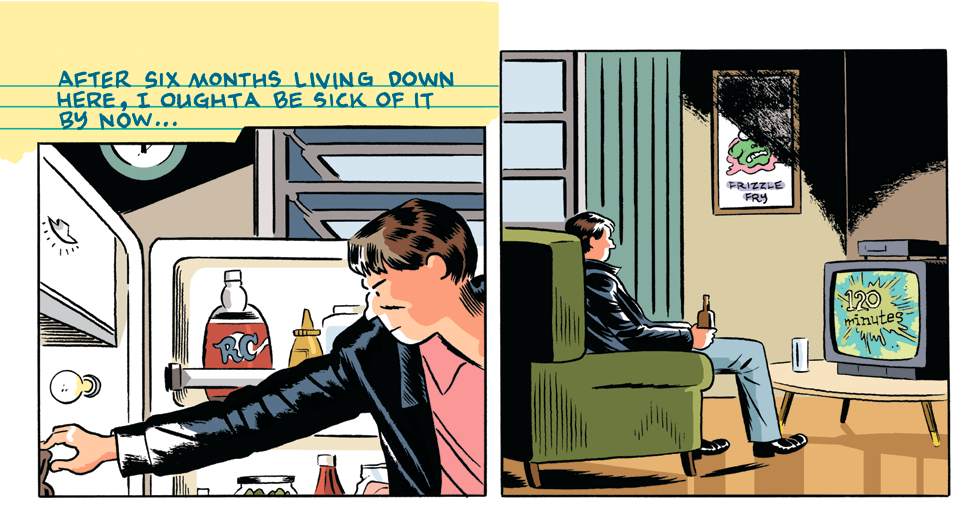Palm trees and plenty of pink
At Westfield Comics Blog, comics artist/writer Rich Tommaso talks about Dry County, a now-collected five-issue comic that's both a tribute to detective pulp fiction and lightly rooted in autobiography. The Eisner Award winner mentions specifically having mined '80s and '90s crime paperback covers for design inspiration and color schemes:
Three out of six of the comics I was working on (for my imprint called Recoil Comics) were crime stories, so I looked at a lot of crime book designs. Namely Keith Sheridan’s 1990s designs for Black Lizard’s Vintage Crime series published by Random House. His most impressive designs were for the great crime novels by Jim Thompson. I also looked at the early ‘90s new designs for Elmore Leonard’s novels by the famous Chip Kidd. Also, some earlier books made in the ‘30s and ‘40s—and the Criterion DVD covers—made a big impression on me as well.
Tommaso has long been interested in drawing crime yarns, be it those he's published at his micro press Recoil or books that have found a home at Image Comics. While I appreciated his Dark Corridor for its refreshing characters, I didn't find the same appeal in Dry County's cast—I couldn't be moved to care about any complications that ensued for the couple I barely knew at the story's center. But just as Dark Corridor is adorned with fetching backdrops, I warmed to the presentation of the new comic's geography, which is crisply depicted throughout the book in vivid colors and clever layouts.
Dry County's lanky, mop-topped protagonist is "Lou Rossi, gag cartoonist for The Miami Herald," but Tommaso lets us think he's a gumshoe P.I. for a beat. Based loosely on the creator as well as his late brother, Rossi isn't a detective of any kind (they're often amateurs in detective fiction). Instead, he's a sullen bachelor who, amid battling very relatable disillusionment with adulthood and his freelance gig, stumbles onto a kidnapping plot.
While the writing of the story took shape back in 2001, it's set in the 1990s' heyday of alt rock and hip Volkswagen commercials, but vintage detective novel staples are all here: The sweltering heat is battled with wheezing table fans, Rossi is clad in boxy suits and skinny ties for dates, and there isn't any shortage of palm trees. There’s even a trademark “Enter the dame” scene, when we're introduced to freckled blonde Janet Laughton, Rossi's love interest ("Boom! And there she was—a blonde goddess sitting right there in the laundry room...").
When Rossi meets Laughton at his building's laundromat, time ticks away as a wash cycle commences—we peer in at wilting tube socks through an array of drawings of the washer door's coin-shaped glass window. Later, a six-panel breakout dissects a close-up of a sweating Rossi as he prepares a report for the police. Tommaso has long been dressing up otherwise conventional plot points with smart page layouts: An outlandishly conveyed scene in his 2014-era self-published Sam Hill: The Mysterious Case, for example, positioned a private investigator's rotted third molar and assorted nerve endings at the center of a page that ultimately just depicts a pedestrian collision on the sidewalk.
For the distinctly loud cover typography and snappy, uniform branding of the Recoil books and as well as his Image stuff, per the Westfield interview, you can pick up on the book design cues Tommaso absorbed in those '90s-era block-type-heavy crime novel covers, specifically those that marketed Elmore Leonard to the audience that was surging into theaters for the popular film adaptations of his fiction at the time.
All of Dry County's narration is scrawled in blue pen ink on scraps of yellow legal notepad paper. It's emphasized in all-caps and either placed just behind the panels or set as if directly pasted on top of the art. The notepad pages' frayed edges, scrapbook-style, occasionally obscure part of the visuals, but Tommaso's sun-baked downtown Miami remains front and center. He renders clusters of the city’s Art Deco buildings in clean lines and bright pastels, dressing the candy box-like facades in flashy graphic elements and protruding geometric shapes. The book's coral pinks and sky-blue gradients glimmer at every turn—they're a stark contrast to the bumbling slackers and detective genre archetypes here, but Dry County dazzles aesthetically, much like those crime novels did from their racks some twenty years ago.
—
Rich Tommaso's Dry County is available now from Image Comics. Interiors © 2018 Rich Tommaso, courtesy of Image Comics.


